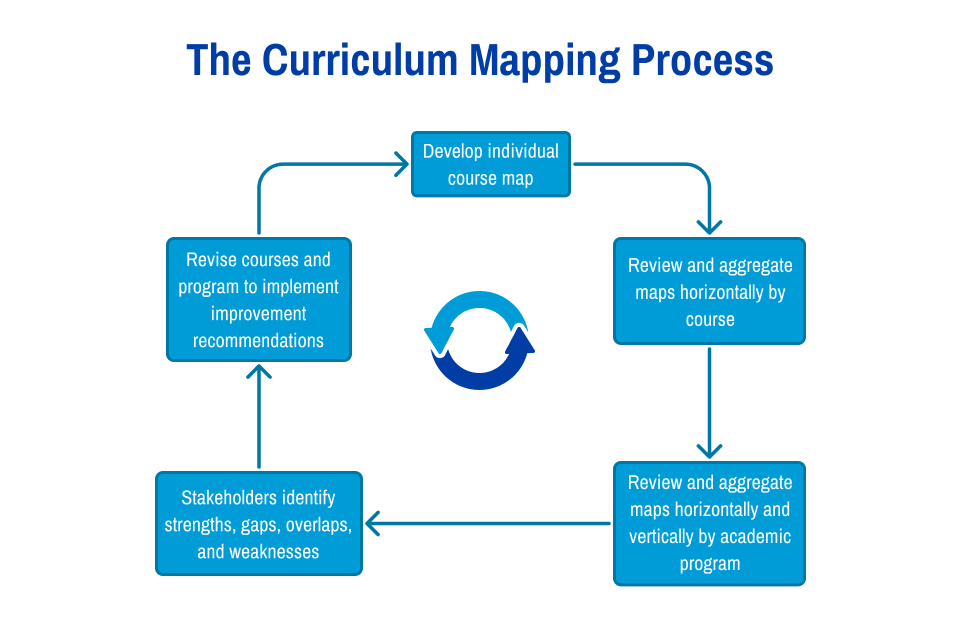Curriculum Mapping as a Tool to Inform Program Design
07/01/2024
Have you ever been excited to learn about a particular topic, only to attend the session and find yourself disappointed? Perhaps the material was overwhelming or lacked alignment with the outlined learning outcomes. As with many aspects of medical education, the details matter. Curriculum design is a complex process that involves tasks related to design, implementation, assessment, and evaluation and optimization of academic programs. An important component of curriculum development is curriculum mapping.
Curriculum mapping is a method to align instruction with desired goals and outcomes to ensure the connections are easily visualized. Two attributes are key: communicability and transparency. These are essential for explaining how, when, and what is taught and identify how learners are being assessed. For the purposes of this post, we define a course as a structured educational unit of teaching, usually covering an individual subject, that includes sessions on individual topics. We define an academic program as a collection of courses to complete a specific degree. On a program level, curriculum mapping represents connections between individual courses and the desired program learning outcomes by identifying which courses within the curriculum introduce, develop, or assess those outcomes and skills. On a course level, curriculum mapping links course content and assessments to learning outcomes at the session, course, and program levels. Often, mapping will reveal gaps or repetition in the curriculum or course content and aids the learner in understanding how their assessments align with their learning outcomes and program outcomes.
Making the Case for Curriculum Mapping
Curriculum designers use forms of representations or diagrams to help manage the complexity and guide the decision-making process. Curriculum representations, including curriculum maps, provide a method for communicating and collaborating with others during the design process and are important for several reasons:
- Promotes educational alignment and coherence: Through curriculum mapping, institutions can align their courses and programs with academic standards, fulfill accreditation requirements, and ensure that every element of the curriculum contributes to a unified educational experience.
- Informs curriculum enhancement: Curriculum maps help enable educators to identify gaps in the curriculum, ensure content coverage, and adjust teaching strategies to improve student achievement using an evidence-based approach.
- Puts student learning into context: Helps students know where they are in the curriculum, where they are going, and where they have been. Students may not remember every aspect of their coursework, so a searchable curriculum map is helpful for knowledge retention, building a study plan, and preparing for comprehensive program assessments.
- Improves faculty understanding: Teaching faculty must understand what information students have been provided and what to prepare for in the future. A curriculum map will help identify multiple touch points on a topic and avoid unintentional gaps or duplications.
- Serves school’s need for documentation: A robust curriculum map can provide all stakeholders with a high-level view of the fulfillment of the program’s education outcomes and insight on processes and timelines for benchmark achievements.
The Process of Curriculum Mapping
Curriculum mapping is a cyclical and iterative process. The first step involves the development of individual maps for each course in the
curriculum. These maps are aggregated by course faculty and administrators and reviewed
by course horizontally, to ensure cohesive integration in parallel disciplines, such as Anatomy and Physiology.
The maps are also reviewed by course and program outcomes to ensure horizontal and
vertical integration between different disciplines within the academic program. The
key stakeholders then identify strengths, gaps, overlaps, and weaknesses in the curriculum.
Courses and academic programs are then revised to implement necessary revisions and
the process begins anew.
The Contents of a Curricular Map
For each course within a program, it is important to confirm that the course learning outcomes meet the program outcomes. To create a successful map, the curricular elements should map within the following four categories:
- Learning expectations: Includes institutional learning outcomes, program learning outcomes, course learning outcomes, and session learning outcomes.
- Course information: Incorporates course code, credit unit, student level, learning venue, session title, session duration, weekly presentation/theme, instructor name, key words/granules, and required reading assignments.
- Pedagogy: Identifies instructional methods and resource types used.
- Assessment: Outlines both formative and summative assessment types.
Mapping Challenges
As with any curriculum assessment, you might encounter challenges when mapping a curriculum across programs. There may be some misconceptions about what courses to include. It is best to start out simple and only map required courses, adding in elective courses once those are set. Single courses with multiple instructors may require coordination among faculty members that participate in teaching and some standardization as to what is covered and what assessments are used. Finally, the curriculum should drive the assessment; however, the program learning outcomes should shape the curriculum and the overriding outcomes should be considered first.
Curriculum mapping is not simple, but it is a valuable and worthwhile endeavor for educators to ensure depth and breadth of core concept coverage and skill development. The purpose of an academic program is to help ensure a comprehensive curriculum that prepares students for professional practice. Tracking when, where, and how content is delivered and assessed can inform curriculum design and re-design to ensure your program successfully meets learner, institutional, and accreditation standards.
 Alicia N. Pate, Ph.D., is the director of physiology education and assistant professor
in the Center for Anatomical Sciences and Education at the Saint Louis University
School of Medicine. Pate's areas of professional interest include curriculum development,
mentorship, and advocacy for gender equality in science. Pate can be found on LinkedIn or contacted via email.
Alicia N. Pate, Ph.D., is the director of physiology education and assistant professor
in the Center for Anatomical Sciences and Education at the Saint Louis University
School of Medicine. Pate's areas of professional interest include curriculum development,
mentorship, and advocacy for gender equality in science. Pate can be found on LinkedIn or contacted via email.